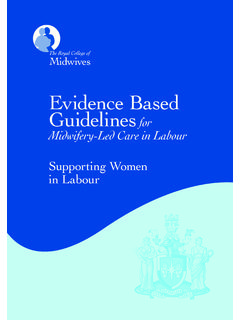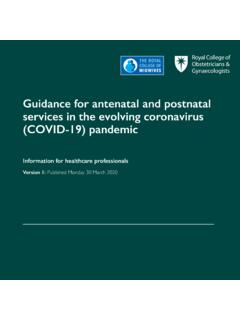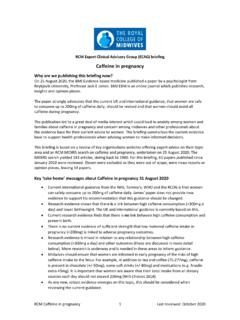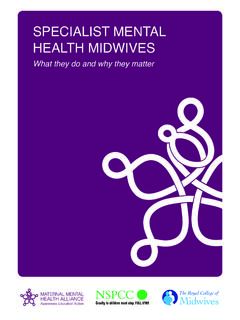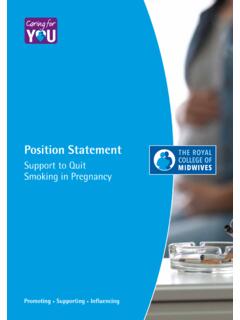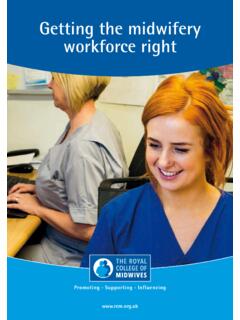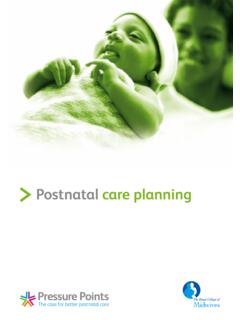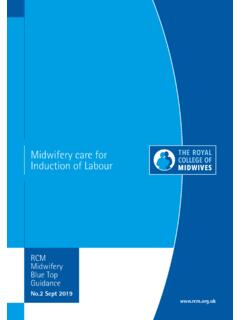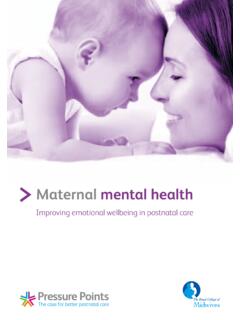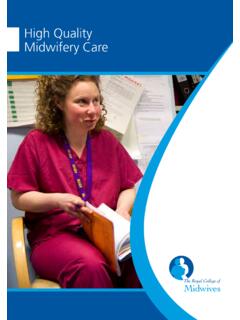Transcription of Position Statement - RCM
1 Promoting Supporting InfluencingPosition StatementMidwifery Continuity of Carer (MCOC)RCM PositionPosition Statement Midwifery Continuity of Carer (MCOC)The RCM supports the aim that midwifery continuity of carer across the maternity journey should be the central model of maternity care for women. The definition of Midwifery continuity of carer (MCOC) used by the RCM is continuity across the whole continuum: antenatal, intrapartum and midwifery continuity of carer model should be the foundation of maternity care, in which women receive seamless care from a primary known midwife for the majority of their care.
2 A midwifery continuity model works within and alongside the multi-disciplinary maternity team. Some women will need care from a range of professionals in addition to their primary midwife. The opportunity for women to build relationships with their key maternity care providers should be built in to the design of maternity systems. The development of midwifery continuity of carer as the central model of care requires a very significant shift in the way in which maternity services in the UK are delivered. In order to make the transition from the current model of care to a model based around MCOC safely and sustainably, the RCM believes that a number of key conditions must be in place.
3 Ring fenced investment in implementation of MCOC Safe levels of midwifery and wider maternity team staffing Flexibility and self management for MCOC midwives and teams Respect for employment and working time regulations Enablement and co-production Team working and mutual respect EvaluationThe RCM believes that the potential benefits of MCOC for women, families and midwives, make it worth the effort of putting these conditions in place to support the implementation of a safe and sustainable MCOC maternity Midwifery Continuity of Carer can be providedThe evidence from randomised controlled trials is that MCOC can be successful in improving outcomes for women and babies both in a one to one caseload model of care, a small team model and a hybrid of the two.
4 Government policies in England and Scotland suggest a small team model with a named primary midwife providing the majority of RCM s Position is that a MCOC team should be no less than 6 and no more than 8 midwives. This balances the need to ensure that any on call commitments are not too onerous, while ensuring that the level of continuity is not negatively impacted. MCOC can be provided in hospital or community settings and across both. MCOC can and should be provided in conjunction with the wider multidisciplinary maternity team the primary midwife coordinates and navigates care for women, whatever their level of need.
5 Each MCOC team should have a named link obstetrician and will ideally be supported by a maternity support worker (MSW). Necessary conditions for Midwifery Continuity of Carer to be implemented well and sustainedMoving from the current models of maternity care in the UK to a model based around midwifery continuity of carer is a very significant shift. Such a shift requires investment, leadership and careful planning. The right conditions are needed for MCOC models to be successfully introduced and maintained for the long term: Ring fenced investment in implementation of MCOC Creating a new MCOC model of care across a maternity service requires significant investment to ensure that a safe service can continue to be provided during the period of transition.
6 Investment should include funding to release staff for training and shadowing opportunities to be confident and competent to work in new ways. Investment should include the provision of the right equipment to all members of the maternity team to be able to work safely in new areas. Adequate finance should be provided to ensure that the appropriate physical environments are created to support MCOC . These community hubs will need to include community based offices, clinical rooms and meeting spaces for continuity midwifery teams. Safe levels of midwifery and wider maternity team staffing Midwifery and wider team staff shortages must be addressed as the key priority by all maternity services.
7 Services that are currently unable to provide safe staffing levels will not be able to safely introduce MCOC. Implementation will require at least a temporary increase in staffing to enable the transition to happen smoothly and safely with dedicated project management and leadership roles and smaller caseloads as midwives become acclimatised to new ways of working. The RCM supports the use of the NICE-endorsed workforce planning tool Birthrate Plus to help services determine the number of midwives and MSWs they need. Evidence is so far limited about whether a MCOC model will lead to a need for increased staffing levels once established.
8 Flexibility and self management for MCOC midwives and teams Continuity midwives need autonomy to develop their own working patterns. Individual midwives need control over their own diaries and to create rotas with their buddies or small teams that work for them. MCOC midwives should not be included in routine escalation policies when core services are busy. Protection and assurance for midwives and maternity support workers working conditions, well-being and work life balance. Any change to working practices and conditions must be undertaken with full partnership engagement. Employment regulations and Agenda for Change contracts must be adhered to.
9 No midwife should experience detriment to her pay or conditions as a result of a change to providing midwifery continuity of carer. Flexible and part-time working opportunities must be respected in any system. Midwives must have clear protected time off, adequate periods for rest and breaks and time for training, administration and continuing professional development. Enablement and co-production Midwifery service leaders should co-produce the change process and new models of provision with maternity staff, staffside representatives and service users in their area. One size will not fit all. Team working and mutual respect Positive relationships within and between teams is essential for effective working.
10 Continuity midwives must also work as part of the wider multi-disciplinary team, collaborating continually with colleagues from for example, obstetrics, general practice, mental health, anaesthetics, neonatology, physiotherapy, dietetics, radiology. Equally, it is important that the wider team positively support those undertaking this change and that there is multi-disciplinary buy-in. MCOC midwives need to work closely with MSWs and core midwifery colleagues. Evaluation All models of care need to be continually evaluated to ensure that they are providing high quality care that is, that they are safe, reliable and person-centred.
